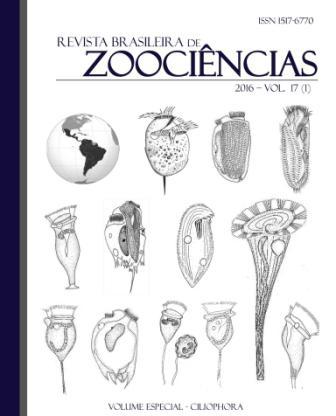Evaluation of sensitivity to zinc and copper of Diophrys appendiculata(Protozoa, Ciliophora) and their associated bacteria, both isolated from a tropical polluted bay
Abstract
Ciliates are an essential component of microbial food webs, connecting biomass production to higher trophic levels and providing substrates for bacterial growth. Bacteria are widespread in sea sediment and the first to metabolize organic matter. Heavy metals are toxic and bind to particulate organic matter. This work aims to study the influence of heavy metals (Zn and Cu) on D. appendiculataand their naturally associated bacteria, both from Guanabara Bay during 96 h bioassay with 0, 0.001, 0.009, 0.05, 0.1 mg L-1 and maximum concentration stipulated by CONAMA 357 (Zn 5.0; Cu 1.0 mg L -1). It was analyzed for tolerance, resistance and biomass production. In Zn control,
ciliate produced 1.24x10 2-2.47x10 3µg C cm -3 (0-96 h), with 0.009 mg Zn L-1 reaches 2.49x10 2 -1.93x10 3µg C cm -3 (0-96 h). Their naturally associated bacteria, in Zn control, produced 5.0x10 -2 -5.67x10 -2µg C cm -3 (0-96 h), with 0.1 mg Zn L-1 4.87x10 -2 -8.38x10-2µg C cm -3 (0-96 h). In Cu control, D. appendiculataproduced 1.04x10 2 -3.12x10 2µg C cm -3 (0-96 h), with 0.009 mg Cu L-1 biomass was 8.31x10 1 -7.27x10 -2µg C cm -3 (0-96 h) and with CONAMA concentration was below detection level. Their naturally associated bacteria, in Cu control, produced 1.20x10-2 -5.14x10 -2µg C cm -3 (0-96 h) and with 0.1 mg Cu L -1 7.40x10 -4 -3.81x10 -2µg C cm -3 (0-96 h), with CONAMA concentration 5.14x10 -2 µg C cm-3 (96 h). D. appendiculataare tolerant to 0.09 mg L -1 and resistant to 0.1 mg L -1 after 24 h to Zn-Cu and LD50 stipulated was 1.17 (Zn) 0.90 (Cu) mg L -1 . Microbial loop was functional in low concentration of Zn and Cu, but their diversity in nature was affected.



